Family : Picidae

Text © Dr. Gianfranco Colombo

English translation by Mario Beltramini
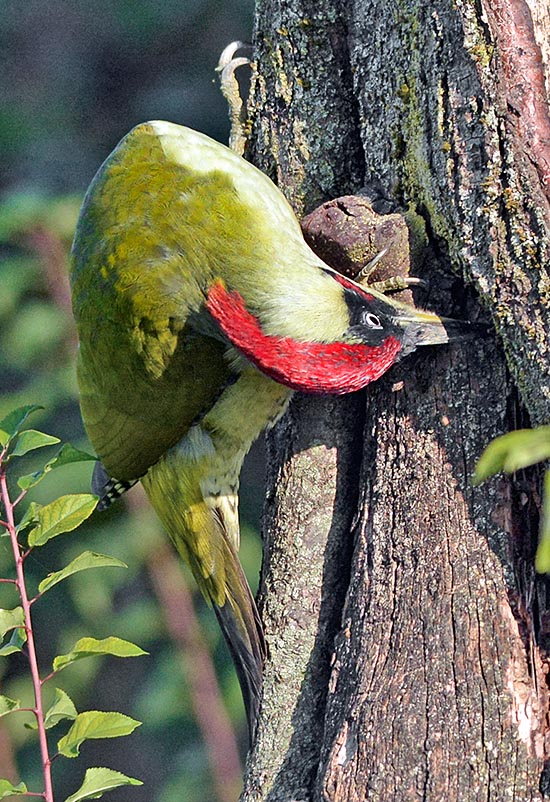
Picus viridis at work. It has an unbelievable thin and sticky tongue, even 10 cm long that introduces with no problem into the anthills and under the barks seeking small preys © Dellera
Almost all picids of our continent have a white and black colour with some more or less marked red spots depending on the sex. Another species has the yellow in lieu of the red and another one, the Eurasian wryneck (Jynx torquilla), the most anomalous of all woodpeckers, has even a nocturnal bird livery.
These two different woodpeckers are the European green woodpecker (Picus viridis Linnaeus, 1758) and the Grey-headed woodpecker (Picus canus) and, as well states the vulgar name, both species have as base the greenish colour.
The green woodpecker belongs to the order of the Piciformes and to the family of the Picidae, a group including arboreal birds usually provided with an exceptionally strong beak suitable for digging in the hardest wood, looking for food as well as excavating their nest.
Each of them then has a particular specialization taking them to differentiate the habitats where they live and also the type of feeding. Along the picids with strong beak, the green woodpecker is absolutely the most terrestrial species as it spends most of the time on the ground looking for its preferred food, the ants and their larvae even if during the winter its quest is addressed towards the arboreal insects it finds under the barks and in the rotting wood of the trees.
This particular aptitude it has to pierce not so hard and tough materials has led this woodpecker to avoid the direct digging of the nest in live trees but to choose those already hollowed by other woodpeckers widening them and adapting them to its necessities. When instead the chosen tree is dead or on the way to be such and the wood is rotting, here it is directly digging the same with a woodpecker typical mastery. It has perhaps grown lazy or, better, it has found more comfortable to do this with less effort.
Many are the legends and the traditions about this woodpecker that have come to us through the centuries. In some North-European countries, it was called the bird of the rain, in relation with a legend that saw it involved at the time of the creation when God sought help from all animals to assist him in digging rivers and lakes and it was the only one who did not offer its service. Hence, it was condemned to never drink from these waterways but to quench its own thirst only with the rain that would fall from the sky. Now, when we hear this vocalization, it’s the green woodpecker asking God for some rain to fall from the sky.
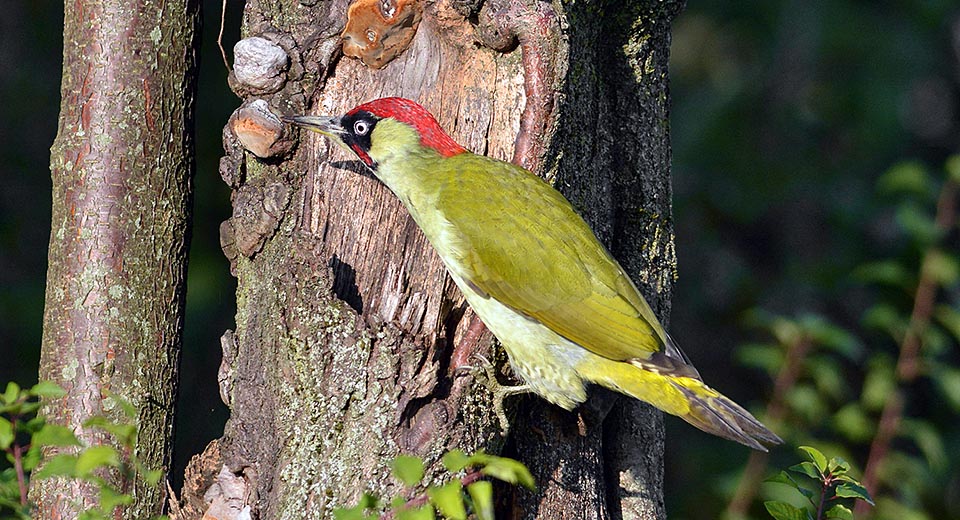
Present in almost all Europe, Anatolia and the Caucasian region, reaches 35 cm with 180-200 g of weight and about half e metre of wingspan © Alvaro Dellera
The most important legend coming from the old mythology and which stands at the origin of its scientific name, relates of a nice young man Picus, king of Latium, who married Canens, mythical nymph singing beautifully. When the goddess Circe was rejected by this young towhom she had offered love, in vengeance turned him initially into a boar and later in a woodpecker. Canens looked for her man madly and in vain till when she dissolved in the waters of the Tiber.
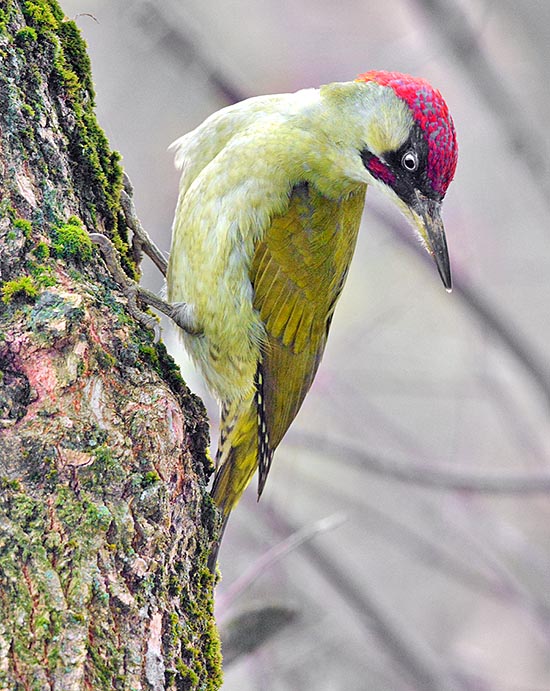
Highly sedentary, even in winter among fogs, never abandons its place © Alvaro Dellera
Also in the European names this colour is recalled. In English, Green Woodpecker; in French, Pic vert; in Spanish, Pito real; in German Grünspecht; in Portuguese, Pica pau verde and in Italian, Picchio verde.
Zoogeography
The green woodpecker is a bird with a range limited to the whole Europe, Anatolia and the Caucasian region. In our continent it is absent only in northern Scandinavia, in northern Great Britain and in Ireland.
In Italy it is well diffused on the whole territory but is absent in the main islands and in some corners of southern Piedmont.
It is a highly sedentary bird with short range errations that do not exceed few kilometres.
Various subspecies have been classified and still now the situation is not completely clear because some of these are by many nowadays considered as new separate species.
It has been determined that Picus viridis (viridis) is the typical European continental species, Picus sharpei is that of the Iberian Peninsula and Picus vaillantii is the one of North Africa. Within the typical European species have been proposed several other subspecies that often overlap in the different territories and hybridize with each other. Hence, we find the Picus viridis pluvius in Great Britain, a Picus viridis pronus in Italy, a Picus viridis karelini in East Europe, in South Italy and Asian area, a Picus viridis romaniae in Romania, then a Picus viridis saundersi, a Picus viridis dofleini, a Picus viridis innominatus and several others. A fluid and not yet definitively clarified situation.
Ecology-Habitat
Like all its similars, the green woodpecker needs environments with several trees but in the mean time ample free spaces, grasslands and grazing meadows, orchards and crops, where it finds its main food.
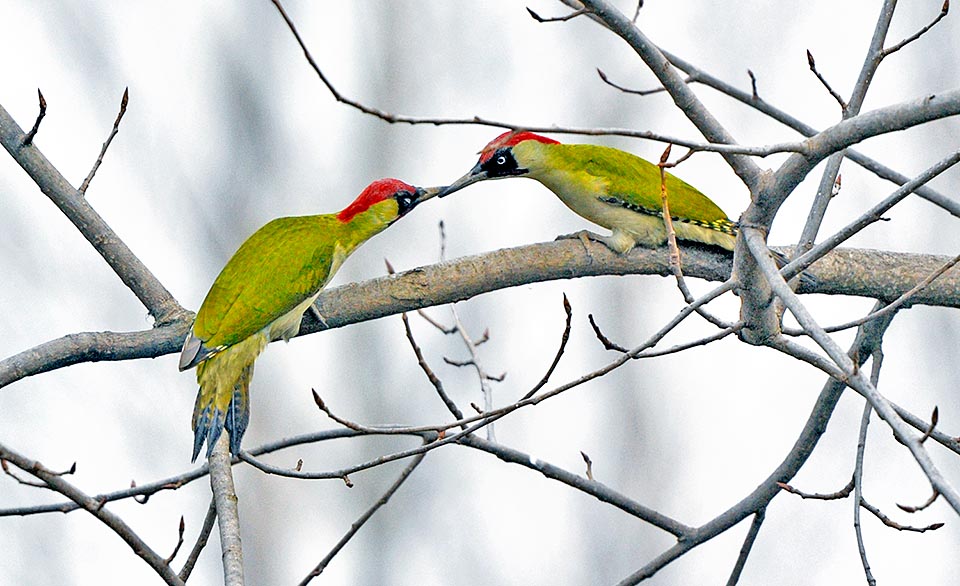
In spring, before nidification, we can see ritualized duels for the territory. Start as fencer than the beaks grapple in a showdown © Gianfranco Colombo
Keeping in mind that this bird spends most of its time on the ground looking for insects, this operation might become very dangerous as well as not very productive inside a thick vegetation. Therefore, it is not strictly linked to thick forests or woods, even if it frequents them at times for necessity but prefers cultivated countries with long lines of trees, small isolated woods and large free extensions.
Morpho-physiology
In Europe, the green woodpecker is second per size only to the big Black woodpecker (Dryocopus martius).
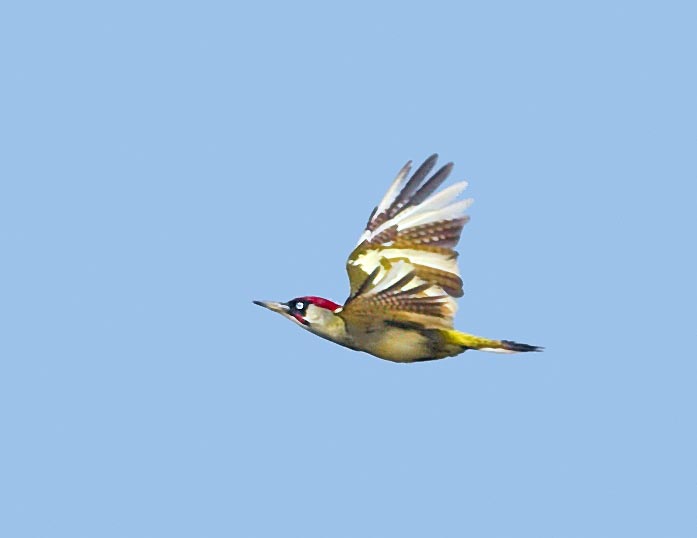
Flying male affected by flavism. It's a brief moment at risk of preys, as when looks for its small preys on the ground or on the trunks, the green woodpecker is very careful and with its mimetic livery goes unnoticed © Gianfranco Colombo
The livery is totally pale green, more or less accentuated on the wings and paler on the chest where tends to cream yellow.
The overtail is bright yellow and the head is crowned by a carmine red hood that goes down backwards to cover the nape. The always greenish tail with slight darker bars, is equipped with very rigid and moderately long feathers.
The very white eyes are inserted in a very black mask that going down on the cheeks draws an ample and well visible black mustache. In the males, inside these mustaches is placed a red band not always visible from far away, being this the only dimorphism between the sexes.
Massive beak, averagely and proportionally bigger than many consimilars. Robust legs, with zygodactylous toes equipped with strong pointed nails of dark colour. Particularly remarkable is the length of the tongue, very sticky, that may reach even the 10 cm and that it uses with great ease inserting it in the anthills and under the bark looking for preys.
The young have a livery that reflects the drawings and the colours of the adults even if in a less lively way and have the whole body dotted by blackish spots. The sexual maturity is reached by the first year even if clear changes in the juvenile livery are already observed a few months after fledging.
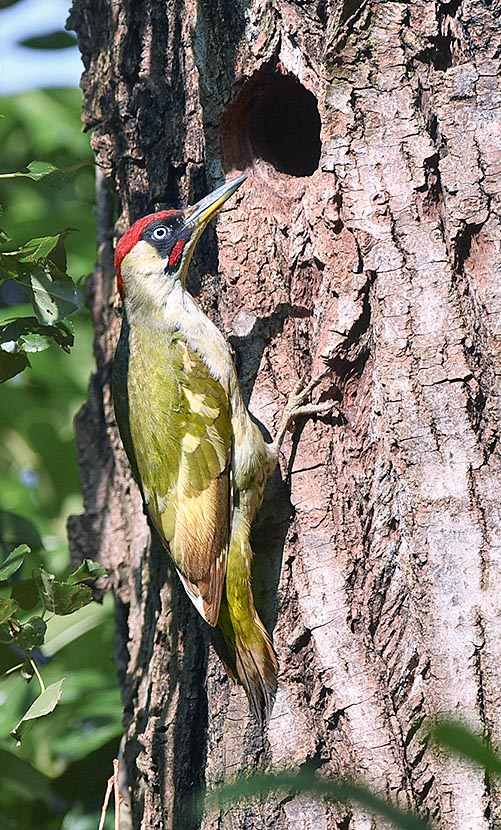
Also while approaching the nest for the hatching relief, our flavist male is elusive, with tricky paths, not to reveal the location © Gianfranco Colombo
The green woodpecker does not love too much drumming as its similars do, therefore it contents occasionally of giving four rapid but delicate thrusts to some dry tree, just to confirm its presence in that place. All to substantiate the fact that its very strong beak is not used with so much violence as usually the real woodpeckers do.
Conversely, it is a real screamer and its presence is easily detectable when hearing that coarse and incontrollable laughter “kuè kuè kuè kuè” that begins rapid and tumultuous and slowing down by the end of the stanza, that emits constantly and in all seasons, when it wanders through the countryside.
It has vocalizations very different from each other, but equally audible and characteristic.
When it flies it emits the typical “kiukiu, kiukiu” rapid and distinct, spacing some fast beat of wings with deep wavy glides with closed wings.
It has then small guttural and little audible signals when close to the female on the nest or at the moment of the relieve at the hatching.
Although so noisy, the green woodpecker is maybe one of the most shy and reserved birds, not easy to sight and immediately ready to get away at the slightest suspicion.
This behavior has its maximum expression during the phase of nidification. The approach to the nest of one of the two partners, also when there are chicks inside, is never direct but very elusive and done with all possible precautions.
It arrives stealthily clinging in the low part of the trunk of some nearby tree, then jumps to the next and so on up to that where it has done the nest. Not happy, it begins the climbing in hops till when it gets close to the entrance hole, but before entering remains hidden a few seconds behind the small branches that usually hide the nest. It is even more difficult to understand during the hatching time, if the owner stands in that hole in the trunk that seems frequented.
The experts know that usually some very light taps on the trunk, given with a small dry branch or a slight scratching with the fingers on the bark, are the simplest way for getting the occupant appearing at the window.
The Great spotted woodpecker (Dendrocopos major) or the Eurasian wryneck (Jynx torquilla) or the Hoopoe (Upupa epops) or, lastly, the Starling (Sturnus vulgaris), some usual occupants of these nests, react with an unthinkable promptness and immediately lean out curious even if then all (but not the starling) get back with the same rapidity and with the most lighthearted nonchalance to the chores in which they were engaged.
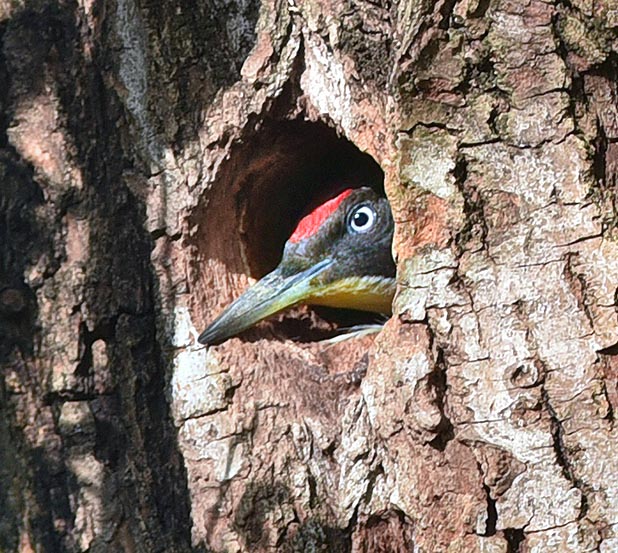
Here appears the female. The nest, often used for more years, is dug in old crumbly trunks, but at times the green woodpecker steals that of the great spotted woodpecker simply widening the hole of few millimeters © Gianfranco Colombo
In order to understand up to which point comes its indifference we might even saw the tree while it is inside, without getting any reaction by this bird.
During the summer season the green woodpecker nourishes mainly of ants and their pupae whilst in the winter season, of larvae of coleopterans and other insects it finds under the barks or in the decaying wood of dead trees.
The nest of the green woodpecker is quite similar in the hole diameter, to that of the Great spotted woodpecker (Dendrocopos major), so much that it often exploits it widening just a little the opening, for putting inside its own.
The difference of diameter of the hole is finally so reduced that when seen from the ground at the foot of the tree where it is located, a rapid distinction cannot be done easily. A difference of half a centimeter versus the usual 5 of the great spotted is not so easy to note.
With this it does not mean that the green woodpecker does not dig its nest, indeed it does this often, but chooses always woods very weak to dig and often using again the same of the previous brood. Among all woodpeckers it is probably the one doing it, as an average, at lower heights among its consimilars.
They have observed holes dug at less than 2 m of height and others accidentally even at more than 10 m, but as an average it is placed around the 4-5 m from the ground.
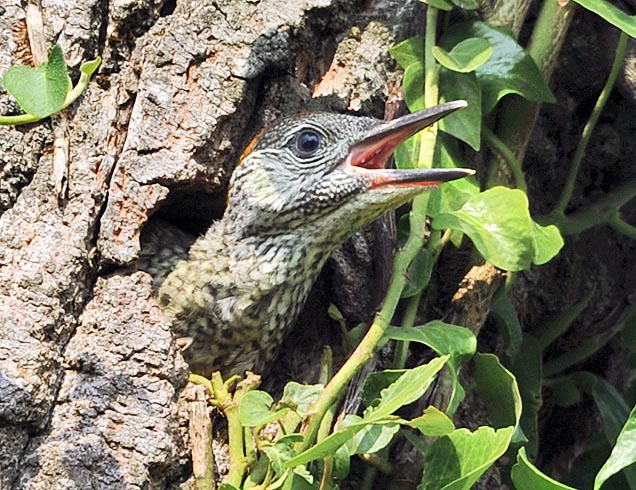
Chick waiting for regurgitated food. 5-7 eggs are laid and to host the numerous brood the hollow inside the trunk may reach even 40 cm with at least 15 cm of length © Gianfranco Colombo
It chooses trees in small woods, old trunks along the banks of a river or a countryside ditch, gardens and public parks but also isolated trees surrounded by simple shrubs that partially cover the trunk. It does avoid the thicker wood and if it does so, it places the nest on trees situated along the edge in way to get in front a totally open space.
The preparation of the nest is always laborious for this woodpecker seen that it must create inside the trunk a vast hollow deep up to 40 cm and at least 15 broad to accommodate the numerous brood. This is a work lasting not less than fifteen days.
The reproduction of the green woodpecker takes place in spring but with a slightly more delayed timetable than its consimilars.
It may accidentally do it in March as well as in late May but at times it gets up to June, in the case of a substitutive laying.
The phases of the courting in the green woodpecker are very particular, quick chases along the trunk, with short hides and seek where one of the partners hides behind the stem and then looks out stealthily towards the other and gentle head sways.
Also the struggle for the conquest of the territory is spectacular. The two contenders face off in silence on a horizontal branch, dueling firstly with the beak like a sword and then grappling them firmly by the tip, trying to overturn the duelist like in a match of Greek-roman wrestling. After a few minutes, always silently and for us observers, without knowing the winner, each one goes its way.
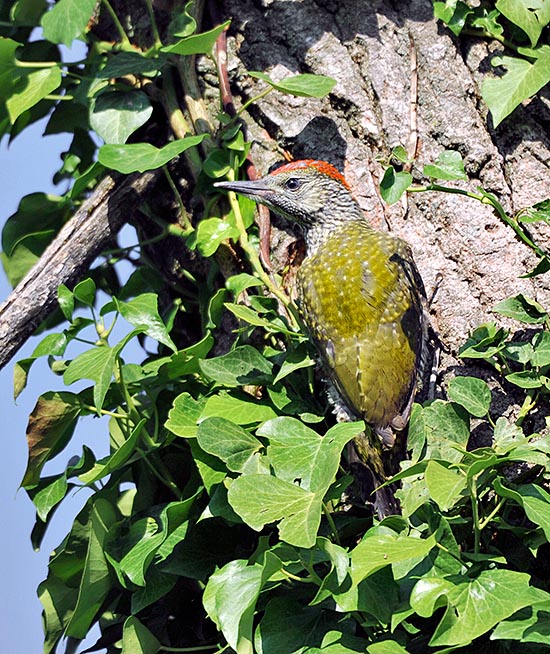
Young female. The young usually stay in the nest for three weeks, but at some point the parents decide to feed them only outside and oblige them to fly © Gianfranco Colombo
In the green woodpecker there is not a real feeding of the young, but a racking of regurgitated and predigested much protein food that greatly accelerates the growth of the chicks. By each feeding it is able to satisfy the whole brood when still small and to satisfy for various hours the single nestlings when already adult.
A few times have been observed green woodpeckers affected by leucism or flavism, also partial. This last anomaly affects parts of the integument of hairs of animals and feathers of birds, making the yellow or dirty white colour to prevail on the original colour of the specimen affected.
Even though during their movements the woodpeckers may be exceptionally attacked by the raptors, usually they do not have foes and the Picus viridis is not standing among the endangered species.
The woodpecker is also represented in heraldry as a symbol of strength, perseverance and endurance. It is shown in some coat of arms of important and noble families to highlight the participation of their ancestors in glorious and important battles.
Finally, there is a religious symbology. The endless research of the worm hidden under the bark done by the woodpecker with its pointed beak, identifies the strength with which the good seeks incessantly to fight the evil.
